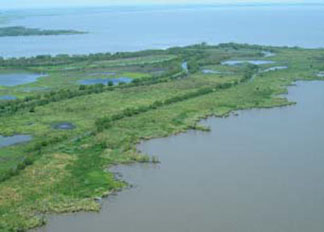Conserving America's Wetlands 2008:
Four Years of Partnering Resulted in
Accomplishing the President's Goal
Appendix I.
Coastal Wetlands Planning, Protection and Restoration Act (CWPPRA)
Table I-1. CWPPRA Funding Supporting the President's Wetland Goal in FY 2009 (millions of dollars)
| Program |
Restore or Create | Improve | Total Wetlands Funding for Goal FY2009 | Difference from FY2008 |
| CWPPRA | 8.426 | 74.993 | 83.419 | 7.004 |
Table I-2. CWPPRA Acres by Agency Supporting the President's Wetlands Goal in FY 2009. Planned Accomplishments (in acres)
| Program |
Restore or Create | Improve | Total Wetlands FY2009 | Difference from FY2008 |
| EPA | 7 | 0 | 7 | 0 |
| FWS | 1,557 | 2,643 | 4,200 | 3,473 |
| NOAA | 745 | 25 | 770 | -316 |
| NRCS | 78 | 25,545 | 25,623 | 23,848 |
| USACE | 755 | 0 | 755 | 261 |
| Total | 3,142 | 28,213 | 31,355 | 27,266 |
The Coastal Wetlands Planning, Protection and Restoration Act (CWPPRA) is funded by the Aquatic Resources Trust Fund (Wallop-Breaux fund), which was passed in 1990 and is authorized until 2019. The fund is created from excise taxes on fishing equipment and on motorboat and small engine fuels. Funds are distributed to the Louisiana Coastal Wetlands Conservation and Restoration Task Force, North American Wetlands Conservation Act Program, and the National Wetlands Conservation Grant Program at rates of 70 percent, 15 percent, and 15 percent, respectively.
The CWPPRA funding distributed to the Louisiana Coastal Wetlands Conservation and Restoration Task Force is used to design and construct projects to preserve, re-establish, and enhance Louisiana’s coastal landscape. Over the past 17 years, the Louisiana portion of CWPPRA has provided an average of
$60 million per year. However, the funding has increased steadily in recent years. Between FY 2005 and FY 2008 the funding for the Louisiana portion of CWPPRA increased from about $58 million to $81 million. The USACE administers the funding and tracks project status of all CWPPRA projects. With the USACE as chair, a
task force consisting of NOAA’s National Marine Fisheries Service, FWS, NRCS, EPA, and the State of Louisiana (the non-federal sponsor) manages the program.
Currently, the program has 175 approved projects, of which 74 are complete and 19 are under construction.
http://www.mvn.usace.army.mil/pd/cwppra_mission.htm
The Louisiana CWPPRA accomplishments are presented in this appendix. The other CWPPRA accomplishments are presented in Appendix F under the appropriate FWS program areas. In addition to the 31,355 acres of coastal wetlands restored, created, and improved reported above in Table I-2, the Louisiana CWPPRA will conserve 316 acres in FY 2009 that would otherwise be lost by protecting shorelines, diverting freshwater and nutrients, and reinstating hydrology. A map of Louisiana restoration sites is available at:
http://lacoast.gov/maps/coastal_la_2008_restoration_ projects.pdf
Shoreline Stabilization |
|||
|
High rates of erosion are destroying wetland habitats along Louisiana’s coastal areas. Coastline erosion rates on the order of 10 to 30 feet per year have been experienced in Louisiana due to wind-produced waves and/or vessel wakes. The main objective of shoreline protection projects in Louisiana is to stop or significantly reduce the erosion of the shoreline. These shoreline stabilization projects generally include constructing a rock breakwater (sometimes also called a foreshore dike) in shallow water parallel to the shoreline. An access channel is dredged alongside the new breakwater to provide sufficient navigational clearance for barges delivering rock. The rock is placed on geotextile fabric, typically situated on soft organic materials, and is expected to experience rapid settlement; therefore, future maintenance lifts of additional stone are planned. The Coastal Wetlands Planning, Protection and Restoration Act (CWPPRA) South White Lake Shoreline Protection Project is located along the southern shoreline of White Lake in Vermilion Parish, La. This shoreline had been retreating at an estimated average of 15 feet per year as a result of wind-driven wave energy. Continued shoreline erosion would have likely breached low marsh management levees and increased interior marsh loss rates in this area. |
The construction of segmented breakwaters along 61,500 linear feet of shoreline is expected to preserve 687 acres of shoreline and interior marsh over 20 years. These breakwaters were gapped periodically throughout their length, allowing free movement of aquatic organisms and water. Approximately 270,000 tons of stone was placed on geotextile fabric. About 172 acres of emergent marsh was created landward of the breakwaters through the beneficial use of dredged material from the digging of the site access channel. The Louisiana Coastal Wetlands Conservation and Restoration Task Force approved engineering and design funding in January 2003 and construction funding in October 2004. Project construction was completed in 2006. The CWPPRA South White Lake project demonstrates that shoreline protection through stabilization and erosion prevention is a proven technique for protecting Louisiana’s coastal wetlands. |
||











